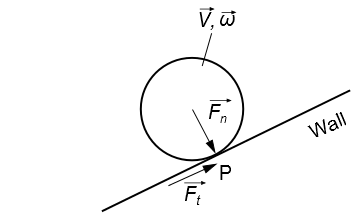For non-rotating particles, Ansys Fluent provides a model that accounts for the energy loss due to inelastic collision with the wall. The particle rebounds off the boundary in question with a change in its momentum as defined by the coefficient of restitution. (See Figure 12.2: Particle Reflection at Wall.)
The normal coefficient of restitution defines the amount of momentum in the direction normal to the wall that is retained by the particle after the collision with the boundary [642]:
(12–193) |
where is the particle
velocity normal to the wall and the subscripts 1 and 2 refer to before
and after collision, respectively. Similarly, the tangential coefficient
of restitution,
, defines the amount of momentum
in the direction tangential to the wall that is retained by the particle.
For rotating particles, Ansys Fluent provides a model for estimating a particle velocity after rebounding from a wall, as proposed by Tsuji et al. [660]. The model is based on classical mechanics (see Figure 12.3: Particle-Wall Collision Forces) and accounts for energy loss due to inelastic collision and friction.
In this model, the time during which the particle and the wall are in contact is divided into two periods; namely, compression and recovery. The system of equations is defined according to whether or not the particle stops sliding within the compression period.
Adhesive Impact
If the particle stops sliding within the compression period, the following condition holds:
(12–194) |
The limiting case of equality in Equation 12–194 corresponds to the Coulomb friction law (Equation 12–505), where the tangential force is directly proportional to the normal force
, and the proportionality factor is the friction
coefficient
.
The momentum equations for the particle motion before and after the collision with the wall are as follows:
(12–195) |
|
where, | |
|
| |
|
| |
|
| |
|
| |
|
| |
|
the superscript | |
|
the subscripts |
The coefficient of restitution is defined as the ratio of the momenta in the normal
direction before and after the collision. If the particle mass remains
constant during rebounding off the wall, the coefficient of restitution
can be simply defined as the ratio of the particle normal velocities
before and after the collision:
(12–196) |
The angular momentum in the wall normal direction is not affected
by the collision, that is . This results in static (unchanging) particle
angular velocity:
(12–197) |
For adhesive impact, the following boundary condition for the particle velocity at the point of contact with the wall can be defined:
(12–198) |
where the superscript refers to the particle velocity at the contact point
during collision (see Figure 12.3: Particle-Wall Collision Forces).
For a given boundary condition, the post-collision velocities, and
, can be computed by solving Equation 12–195.
Sliding Impact
If the tangential force exceeds the frictional force (that is, the inequality in Equation 12–194 is not fulfilled), the particle does not stop sliding within the compression period. The particle linear and angular velocities are not correlated kinematically, and post-collision velocities can be estimated directly from the respective momentum equations. Equation 12–196 and Equation 12–197 are still valid. The change in the tangential momentum can be defined using Equation 12–194 as follows:
(12–199) |
where,
(12–200) |
where is the sign function that returns +1 for positive
values and –1 for negative values.
Note: When particle rotation is enabled, the tangential coefficient
of restitution (the DPM tab of the Wall boundary condition dialog box) is not taken into
account. The tangential linear velocity of a particle after rebounding
from the wall is a function of both the particle’s linear velocity and its angular velocity
before the collision.
See Particle Rotation in the Fluent User's Guide for information about how to use the particle rotation model.




